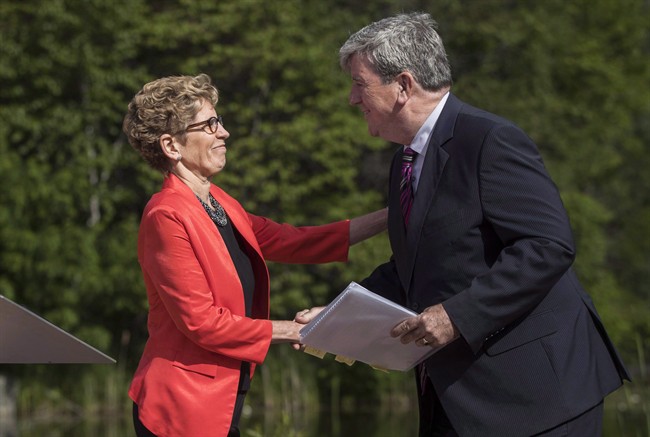“There are moments in your life that do not present themselves as choices but as imperatives. When I turned 20 years old, AIDS was not a word in my vocabulary but by the time I turned 30, it had taken 43 of my friends and loved ones … For someone who has lived through one global tragedy and is now faced with the greater crisis of climate change, walking away from this fight isn’t in my DNA.”

With those words, Glen Murray, Ontario’s Minister of Environment and Climate Change, officially decamped from Queen’s Park to Calgary, resigning his cabinet post for a job heading the Pembina Institute, a clean energy think-tank.
The announcement caught Ontario’s political class by surprise, and naturally prompted much speculation about rodents and sinking watercraft. Despite a small bump in recent polls, the Liberals are still trailing the Tories less than a year from a provincial election. If the trends hold, the Liberals will lose seats even in their stronghold of Toronto — and Premier Kathleen Wynne’s approval rating remains the worst in the country.
But the scenario conjures up eerie reminders of ministers bailing from the federal Conservative cabinet in the run-up to the 2015 national election campaign, when John Baird, Peter Mackay, James Moore, Shelley Glover, Diane Ablonczy and Christian Paradis took a walk in the snow — and never came back.
Could the Liberals see the same sort of trend at work here? That depends, in part, on where those fleeing the burning deck think they could land; Murray claims his new post is a “dream job” but it’s interesting that he is leaving the province to take it.
For a lot of Ontarians, jobs are indeed becoming a dream: In a remarkable reversal of fortune, Quebec’s economy is now outperforming Ontario’s and enjoying a lower jobless rate than its neighbour. Add to this the sky-high cost of housing and hydro rates, and leaving the province for greener pastures could present an attractive option.
Murray, of course, is exiting a portfolio inextricably linked to one of the government’s worst-performing files: the Green Energy Plan. The province’s shuttering of coal-fired electricity plants and incentives to renewable energy companies under the previous Liberal government of Dalton McGuinty saw hydro ratepayers spend $37 billion more than necessary between 2006 and 2014, due to the province’s so-called “global adjustment” of electricity fees.
That adjustment is the differential between what energy producers are paid for their electricity and the actual fair market rate it would command. On a consumer’s hydro bill of $100, the fee could represent as much as $77.
In a scathing report, Auditor General Bonnie Lysyk estimated that ratepayers could end up paying $9.2 billion more for renewable energy through contracts issued under the Green Energy Act, with guaranteed prices set at double the U.S. market price for wind and at 3.5 times the going rate for solar power. “With wind and solar prices around the world beginning to decline around 2008, a competitive process would have meant much lower costs,” she concluded.
This year, both Lysyk and the province’s financial accountability officer Stephen LeClair slammed the Liberals again for their latest plan to amortize the province’s hydro debt, which would cost $45 billion to save $24 billion — assuming that the province balances its books and does not finance the amortization through new borrowing. The goal is to shave 25 per cent off electricity bills — by extending the amortization from 25 to 30 years.
In this climate, some observers think Murray’s departure might actually give Wynne the chance to find a fresh start on the issue. Global News Queen’s Park Bureau Chief Alan Carter said that “Minister Murray was always colourful, but his habit of shooting from the lip made many senior Liberal staffers nervous. His departure really doesn’t hurt Wynne’s re-elections chances, and in fact could help by eliminating any potential gaffes in 2018.” Carter adds that he doesn’t necessarily see more resignations on the horizon — at least for now.
Which would be good news for Wynne, who is pulling out all the stops to turn things around in the lead-up to next year’s vote. Apart from the hydro refinancing, she has promised to take the province’s minimum wage from $11.40 to $15 an hour by 2019, add more money for daycare, and conduct a study of high-speed train service from Toronto to Windsor. She implemented a foreign buyers’ tax which has slowed housing price increases, expanded rent control and brought in pharmacare for all Ontarians under 25.
Whether she can cannibalize enough of the NDP vote through such left-leaning measures, and attract enough Tories still unsure about new leader Patrick Brown, remains an open question — but if she pulls it off, perhaps Murray will wonder whether heading West was the right decision after all.
Tasha Kheiriddin can be heard between noon and 2 p.m. ET on Toronto Talk Radio AM640. She’s also a columnist with Global News and iPolitics.ca, where this piece first appeared.













Comments